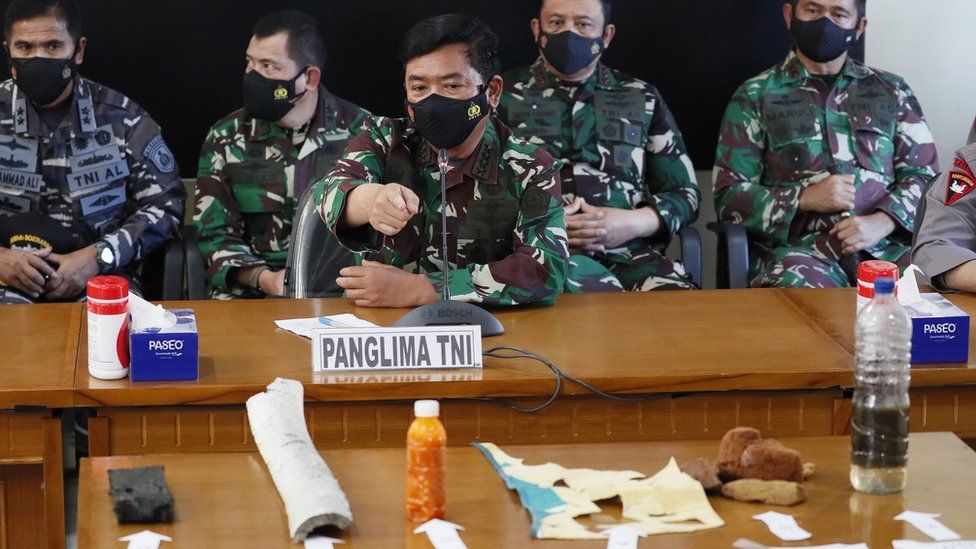Indonesian Tragedy At Sea
"If it’s an explosion, it will be in pieces. The cracks happened gradually in some parts when it went down from 300 metres to 400 metres to 500 metres. … If there was an explosion, it would be heard by the sonar.""We have found several pieces and parts that are believed to be parts or components that are attached to the submarine that would not come out of the ship if there had not been pressure from outside or a crack in the torpedo launcher.""With the authentic evidence we found believed to be from the submarine, we have now moved from the `sub miss’ phase to `sub sunk'."Indonesian Navy Chief of Staff Adm. Yudo Margono
 |
| A submarine missing since Wednesday off the coast of Bali with 53 people on board has been lost, the Indonesian navy said on Saturday. EPA |
"[The crew could still be found alive].""But if the submarine is in a 700-nmetre sea trough, it will be difficult for them to survive because underwater pressure will cause cracks and ruptures of the steel hull."Connie Rahakundini Bakrie, Indonesian defence expert"When you factor in the oxygen levels for the actual number of crew and then the time it takes to locate, assessment of recovery, then engagement in that recovery that timeline looks even longer."Natalie Sambhi, expert on Indonesian military and security, Verve Research"We've indicated that we will help in any way we can.""We operate very different submarines from this one, but the Australian Defence Force and Australian Defence organization will work with defence operations in Indonesia to determine what we may be able to do."Australian Foreign Minister Marise Payne
Time has not been on the side of rescue operations in the urgency of the missing Indonesian Navy submarine with 53 crew aboard missing since Wednesday, lost in the Bali Sea. Speculation with respect to the outcome of the disaster rests on two crumbling pillars; either oxygen would be depleted leading to death, or the submarine has already been crushed by immense water pressure.
Search helicopters and additional ships heading to the area where contact was lost with the KRI Nanggala-402 on Wednesday left Bali and a Java naval base. The head of the Indonesian submarine fleet was aboard the 44-year-old refurbished submarine as it prepared to conduct a torpedo drill. Officials feel that if the submarine was still intact it would have sufficient air to last only until Saturday at dawn.
"So far we haven't found it ... but with the equipment available we should be able to find the location", advised Achmad Riad, spokesman for the Indonesian military. Six tonnes of equipment was flown to a base to assist with the search, which included underwater balloons to help lift the vessel. There is speculation over whether the submarine had lost power during its dive and was unable to carry out emergency procedures, descending to a depth of 600 -- 700 metres, well beyond survivability limits.
Indonesian Navy Chief of Staff Yudo Margono announced that an aerial search had earlier spotted an oil spill close by the last location of the submarine, where an object with "high magnetic force" had been seen "floating" at a 40 to 100 metre depth. A depth of up to 400 metres could be withstood by the diesel-electric-powered submarine, but any greater depth could be fatal in the Bali Sea where depths of over 1,500 are known. Commander Harry Setiawan, commander of the Indonesian submarine fleet was on board.
The submarine, in active service in Indonesia since 1981, underwent a refit in South Korea in 2012, which brought it to good condition. Australia, India, Malaysia, Singapore and the United States all have sent specialized vessels or aircraft to Indonesia's aid in response to its assistance request. U.S.Defense Secretary Lloyd Austin in speaking with his Indonesian counterpart offered undersea search assets, along with the U.S. military's P-8 Poseidon aircraft assisting in the search for the submarine.

The two Australian Navy ships heading toward the search area included a frigate with a helicopter and special sonar capabilities. The Indonesian fleet has five submarines in operation. It has planned to modernize its defence capabilities for some time, in recognition that some of its equipment suffers from elderly fatigue, a result of which has been a few fatal accidents in recent years.

Labels: Bali Sea, Indonesia, Rescue Efforts, Submarine Disaster
0 Comments:
Post a Comment
<< Home